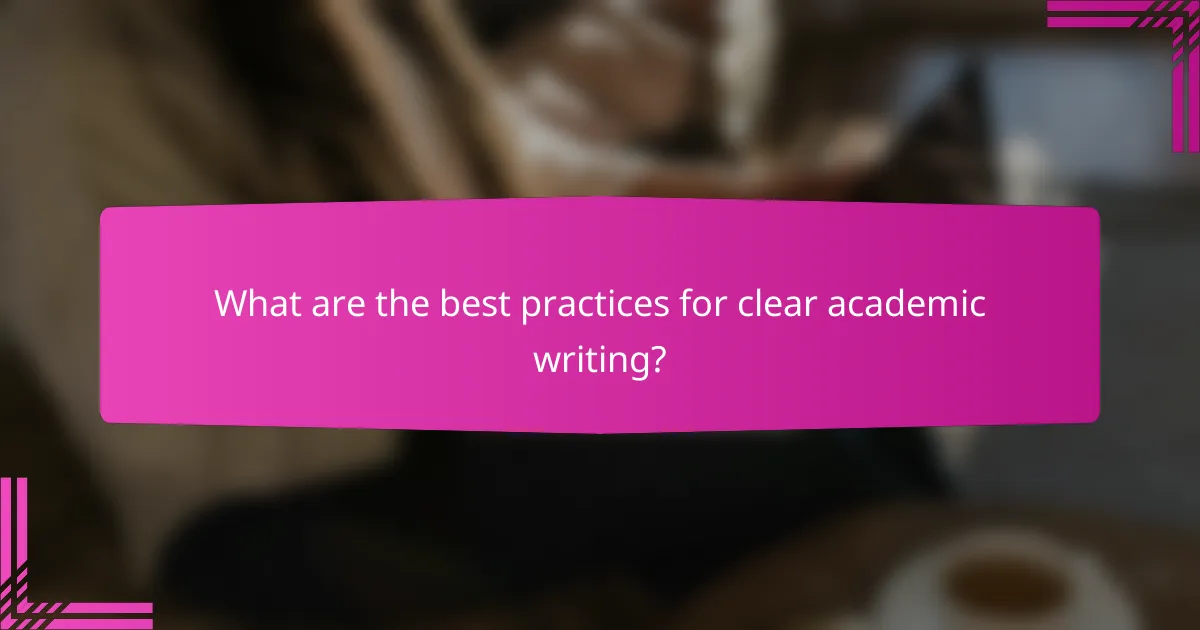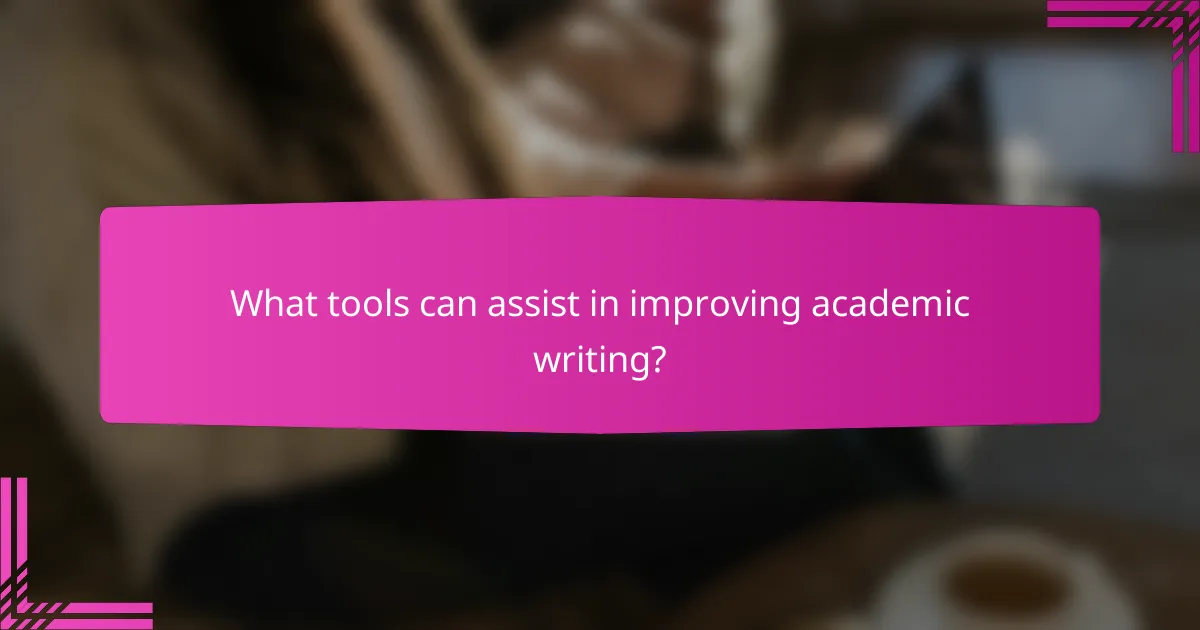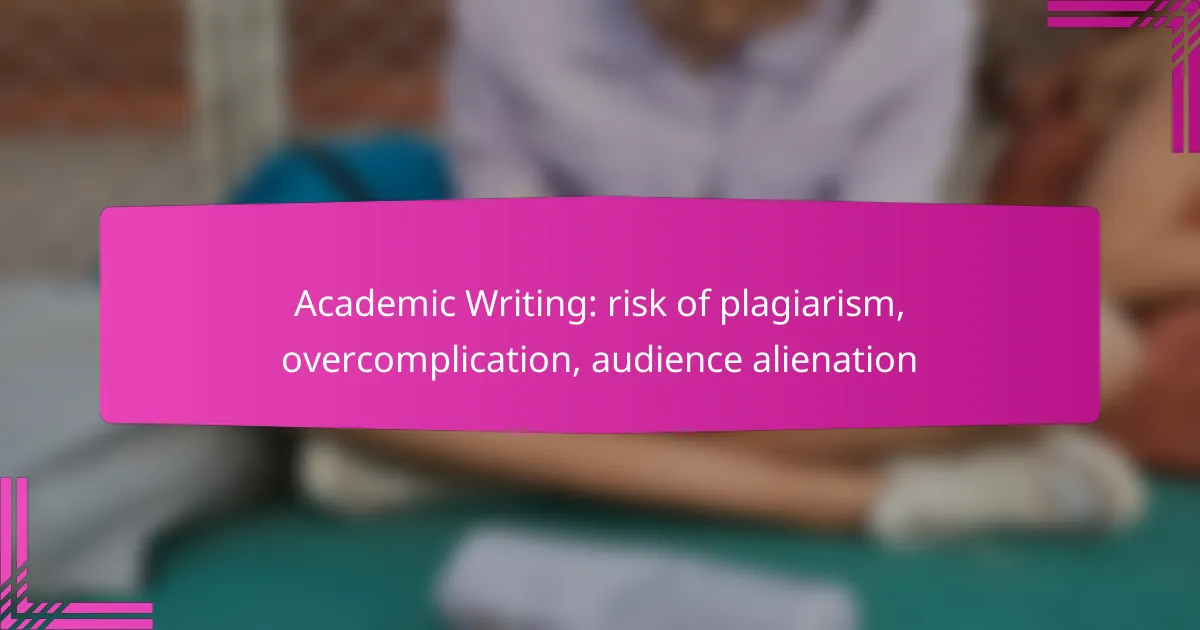Academic writing demands clarity and integrity, as the risks of plagiarism, overcomplication, and audience alienation can undermine the effectiveness of your work. Properly attributing sources and presenting original ideas are crucial to maintaining credibility, while avoiding overly complex language ensures your arguments resonate with readers. Understanding your audience and tailoring your content accordingly fosters engagement and enhances communication, ultimately leading to a more impactful academic piece.

How to avoid plagiarism in academic writing?
To avoid plagiarism in academic writing, it is essential to properly attribute sources and present original ideas. Understanding and implementing effective strategies can significantly reduce the risk of unintentional plagiarism.
Use plagiarism detection tools
Plagiarism detection tools help identify potential instances of copied content before submission. Tools like Turnitin and Grammarly can scan your work against a vast database of sources to highlight similarities. Regularly using these tools can help ensure your writing maintains originality.
Implement proper citation practices
Proper citation practices are crucial for giving credit to original authors and avoiding plagiarism. Familiarize yourself with citation styles such as APA, MLA, or Chicago, and apply them consistently throughout your work. Always include in-text citations and a reference list to support your claims.
Paraphrase effectively
Effective paraphrasing involves rewording and restructuring the original text while retaining its meaning. Instead of simply changing a few words, aim to express the idea in your own voice. This not only helps avoid plagiarism but also demonstrates your understanding of the material.
Understand fair use policies
Understanding fair use policies is important for using copyrighted material without infringing on rights. Fair use allows limited use of copyrighted content for purposes like criticism, comment, or education. Familiarize yourself with the guidelines to ensure your use of sources complies with legal standards.

What are the risks of overcomplication in academic writing?
Overcomplication in academic writing can hinder communication and dilute the effectiveness of your arguments. It often leads to confusion, making it difficult for readers to grasp key concepts and ideas.
Decreased readability
Overly complex language and convoluted sentence structures can significantly decrease readability. When texts are difficult to follow, readers may struggle to engage with the material, leading to frustration and disengagement.
To enhance readability, aim for clear and concise sentences. Use straightforward vocabulary and avoid jargon unless it is necessary for your audience. A good rule of thumb is to keep sentences under 20 words when possible.
Increased misunderstanding
Complex writing can lead to increased misunderstanding among readers. When ideas are not presented clearly, the risk of misinterpretation rises, which can skew the intended message.
To minimize misunderstanding, consider your audience’s background knowledge. Use examples and analogies that relate to their experiences, and clarify any complex concepts with definitions or explanations.
Negative impact on grades
Overcomplicated writing can negatively impact grades, especially in academic settings where clarity is valued. Instructors often prioritize clear communication of ideas, and convoluted writing may be seen as a lack of understanding.
To avoid this pitfall, focus on clarity and coherence in your writing. Regularly seek feedback from peers or instructors and revise your work to enhance clarity before submission. This approach can help ensure your ideas are effectively communicated, potentially improving your grades.

How can audience alienation be prevented?
Preventing audience alienation involves understanding who your audience is and tailoring your content to their needs and preferences. By engaging with your audience and using accessible language, you can create a connection that keeps them interested and involved.
Identify target audience
Knowing your target audience is crucial for effective communication. Consider demographics such as age, education level, and interests to tailor your writing style and content. For instance, academic writing for graduate students may require more technical language compared to content aimed at high school students.
Conduct surveys or research to gather insights about your audience’s preferences. This information can guide your choice of topics, tone, and complexity, ensuring your writing resonates with the intended readers.
Use clear and accessible language
Using clear and accessible language helps prevent audience alienation by making your content understandable. Avoid jargon and overly complex sentences that may confuse readers. Instead, opt for straightforward vocabulary and concise phrasing.
For example, instead of saying “utilize,” simply use “use.” This small change can significantly enhance readability and keep your audience engaged. Aim for a reading level that matches your audience’s capabilities, which can often be assessed through readability tests.
Engage with audience feedback
Actively seeking and incorporating audience feedback is essential for maintaining engagement. Encourage readers to share their thoughts through comments, surveys, or social media interactions. This not only shows that you value their opinions but also helps you understand their needs better.
Regularly review feedback to identify common themes or suggestions. Adjust your writing accordingly, whether that means simplifying language, addressing specific topics, or changing your approach. This responsiveness fosters a sense of community and keeps your audience invested in your content.

What are the best practices for clear academic writing?
Clear academic writing is achieved through logical organization, concise language, and the effective use of visual aids. These practices help convey complex ideas in a straightforward manner, making it easier for the audience to understand and engage with the content.
Organize content logically
Logical organization is crucial for guiding readers through your arguments and findings. Start with a clear thesis statement, followed by well-structured sections that build upon each other. Use headings and subheadings to break up text and signal transitions between ideas.
Consider employing a standard structure, such as introduction, literature review, methodology, results, and conclusion. This familiar format helps readers follow your work more easily and reduces confusion.
Utilize concise language
Concise language enhances clarity and keeps readers engaged. Aim to express ideas using straightforward vocabulary and avoid unnecessary jargon or overly complex sentences. This approach not only aids comprehension but also minimizes the risk of alienating your audience.
As a rule of thumb, strive for brevity by eliminating filler words and redundant phrases. For example, instead of saying “due to the fact that,” simply use “because.” This small change can significantly improve the readability of your writing.
Incorporate visual aids
Visual aids, such as charts, graphs, and tables, can effectively complement your written content. They help illustrate key points and make complex data more accessible. When using visuals, ensure they are relevant and clearly labeled to avoid confusion.
Consider including a mix of visuals to cater to different learning styles. For instance, a bar graph can effectively show trends, while a table can present detailed data succinctly. Always refer to these aids in your text to reinforce their significance and guide readers on how to interpret them.

What tools can assist in improving academic writing?
Several tools can enhance academic writing by addressing grammar, clarity, and audience engagement. These tools help writers avoid common pitfalls such as plagiarism, overcomplication, and alienating their audience.
Grammarly for grammar checks
Grammarly is a widely used tool that provides comprehensive grammar checks, helping writers identify and correct errors in their work. It offers real-time suggestions for grammar, punctuation, and style, making it easier to produce polished academic papers.
When using Grammarly, consider its premium features, which include advanced checks for tone and clarity. This can be particularly useful for academic writing, where maintaining a formal tone is essential. However, be cautious not to rely solely on automated suggestions; always review changes to ensure they align with your intended meaning.
To maximize Grammarly’s effectiveness, integrate it into your writing process early. Use it for initial drafts to catch basic errors and then revisit it after revisions to refine your work further. This iterative approach can significantly enhance the quality of your academic writing.



